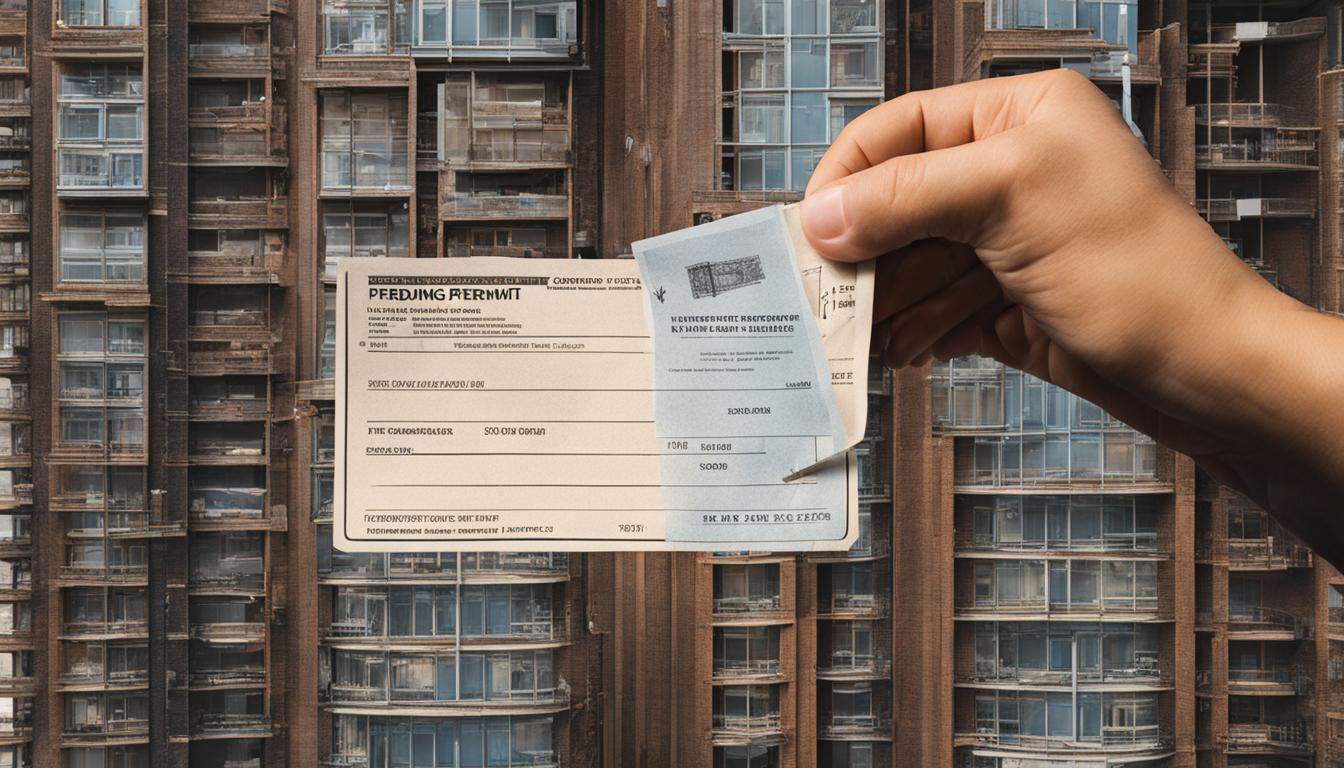If you’re planning a construction project in Long Island, specifically in Nassau County or Suffolk County, you may have questions about transferring building permits. The process can be complex, but with the help of Traci’s Permits, a trusted permit assistance provider, navigating the transfer of building permits becomes much easier. We offer unmatched expertise in the Long Island permit process, ensuring timely approvals and code compliance for both Nassau County and Suffolk County.
For expert guidance and assistance with building permit transfers, contact Traci’s Permits at 631-492-0927.
Key Takeaways:
- Transferring building permits in Long Island, Nassau County, and Suffolk County can be a complex process.
- Traci’s Permits offers unmatched expertise in navigating the transfer of building permits in the area.
- Transferring permits requires understanding the specific rules and regulations governing the process.
- The new owner of a property automatically becomes the entitled person under the permit when it is transferred.
- Consulting with professionals, such as attorneys or architects, can ensure a smooth transfer process.
Understanding Building Permit Transferability
When it comes to construction projects in Long Island, specifically in Nassau County and Suffolk County, the transferability of building permits is an important consideration. Building permits can indeed be transferred to new owners or different locations, ensuring a smooth transition for ongoing projects.
Transfer of Permit Rights:
When a property is sold or transferred during the construction process, the new owner automatically becomes the entitled person under the permit. This transfer of permit rights happens by operation of law and is not dependent on any additional agreements or contracts. Whether it’s a purchase, exchange, donation, or inheritance, the new owner inherits both the rights and obligations under the permit.
Applicability to Building Permits and Zoning Decisions:
This transferability applies to both building permits and zoning decisions in Long Island, including Nassau County and Suffolk County. Whether you are moving building permits to a new owner or transferring construction permits to a different location, the process remains the same – the rights and obligations transfer automatically to the new owner.
In order to navigate the transfer of building permits effectively, it is recommended to seek the assistance of experts who are experienced in the Long Island permit process. Traci’s Permits, a trusted permit assistance provider in the area, offers unmatched expertise in navigating the transferability of building permits. We ensure timely approvals and code compliance for both Suffolk County and Nassau County. For expert permit assistance, contact Traci’s Permits at 631-492-0927.
| Transfer Process | Property Ownership | Permit Rights | Obligations |
|---|---|---|---|
| Transfer of Building Permits | New Owner | Automatically transferred | Inherited by new owner |
| Previous Owner | |||
| Transfer of Zoning Decisions | New Owner | Automatically transferred | Inherited by new owner |
| Previous Owner |
“The transfer of building permits and zoning decisions to new owners or different locations is a seamless process. The rights and obligations under the permit automatically transfer by operation of law, ensuring a smooth transition for ongoing construction projects.”
Understanding the transferability of building permits is crucial for property owners in Long Island, including Nassau County and Suffolk County. By knowing that permits can be moved to new owners or different locations, property owners can navigate the permit transfer process confidently and efficiently.
The Role of Permits in Property Transactions
When a property that has an active building permit or zoning decision is transferred to a new owner, the permit automatically transfers as well. The new owner becomes responsible and entitled to continue the construction project or make changes to the plans, as long as they comply with the original permit conditions. This transfer of permits is governed by specific rules and regulations, ensuring that the new owner can proceed with the project without any disruptions or delays. In Long Island, including Nassau County and Suffolk County, the building permit transfer process is well-established and legally recognized.
Transferring permits between properties is a critical aspect of property transactions, as it ensures a smooth continuation of construction projects. With the transferability of building permits, the new owner can seamlessly carry out the planned development or modifications without the need to go through the entire permit application process again.
The building permit transfer rules in Long Island, including Nassau County and Suffolk County, outline the necessary steps and requirements for a successful permit transfer. These rules provide clarity and structure to the transfer process, enabling property owners to navigate the legalities efficiently.
By adhering to the building permit transfer rules, property owners can save time, avoid unnecessary administrative hurdles, and ensure compliance with local regulations. The transfer of permits between properties demonstrates the commitment of the local authorities to promote the smooth progression of construction projects while maintaining proper oversight.
“The permit transfer process allows property owners in Long Island, Nassau County, and Suffolk County to carry on with their construction plans seamlessly.”
Understanding Building Permit Transfer Rules
Building permit transfer rules entail specific guidelines that property owners must follow when transferring permits between properties. These rules are designed to protect the interests of all parties involved and maintain the integrity of the construction process.
Here are some key considerations related to building permit transfers:
- The permit transfer must comply with the laws and regulations set forth by the local building department.
- Proper documentation, including the original permit, plans, and any modifications, must accompany the permit transfer.
- The new owner must assume all responsibilities and obligations associated with the permit, ensuring compliance with the original permit conditions.
- Any proposed changes or modifications to the plans must be reviewed and approved by the building department before proceeding with the construction project.
- The permit transfer may involve additional fees or administrative requirements, which must be fulfilled by the transferring parties.
Property owners should consult with professionals experienced in building permit transfers to ensure compliance with the specific transfer rules applicable to Long Island, Nassau County, and Suffolk County.
Benefits of Smooth Permit Transfers
Efficient and successful transfers of building permits offer several benefits to property owners and the local community. Some key advantages include:
- Minimizing project delays: By transferring permits seamlessly, property owners can avoid unnecessary delays in project timelines and maintain construction momentum.
- Cost savings: Transferring permits eliminates the need for redundant permit application processes, resulting in cost savings for property owners.
- Preserving the integrity of approved plans: Permit transfers ensure that the construction project adheres to the approved plans and complies with local regulations.
- Fostering economic growth: Smooth permit transfers encourage investment in construction projects, promoting economic growth in Long Island, Nassau County, and Suffolk County.
Overall, the transferability of building permits plays a vital role in sustaining and facilitating construction projects across Long Island, Nassau County, and Suffolk County. By understanding and following the building permit transfer rules, property owners can navigate property transactions with confidence and ensure seamless continuity in their construction endeavors.
| Benefits of Smooth Permit Transfers | Key Considerations for Building Permit Transfers |
|---|---|
| Minimizing project delays | The permit transfer must comply with the laws and regulations |
| Cost savings | Proper documentation must accompany the permit transfer |
| Preserving the integrity of approved plans | The new owner must assume all responsibilities and obligations |
| Fostering economic growth | Proposed changes or modifications must be reviewed and approved |
Smooth permit transfers offer numerous advantages for property owners, including minimizing project delays, cost savings, preserving the integrity of approved plans, and fostering economic growth. However, property owners must also consider key aspects, such as complying with regulations, providing proper documentation, assuming responsibilities, and obtaining approval for changes or modifications.
“Understanding the building permit transfer rules is essential for property owners in Long Island, Nassau County, and Suffolk County.”
The Authority of Building Permits
When it comes to the transferability of building permits, it’s important to understand the authority that these permits hold. Building permits are decisions in rem, meaning they apply to a specific property rather than a specific person. This crucial distinction allows for the seamless transfer of permits when a property changes ownership, regardless of the original applicant or owner.
Unlike permits that are tied to individuals, building permits are tied to the property itself. As a result, when a property is sold or transferred, the new owner automatically becomes the entitled person under the permit. This means that the building permit is not limited to a particular individual but rather to the property itself. This principle applies to both building permits and zoning decisions in Long Island, including Nassau County and Suffolk County.
Understanding the authority of building permits is vital when navigating the transfer process. It ensures a smooth transition of responsibilities and allows the new owner to proceed with their construction project or make necessary modifications under the existing permit.
Handling Permit Transfers in Practice
While the legal framework surrounding the transfer of building permits is clear, practical situations can sometimes be more complex. In some cases, the building authority may request additional documentation or agreements when a permit is transferred to a new owner. However, these requests are not in accordance with the established legal regulations and case law. It’s important to thoroughly evaluate each case individually, considering all the relevant agreements and circumstances. Consulting with legal professionals, such as attorneys or architects, can help ensure a smooth transfer process in Long Island, including Nassau County and Suffolk County.
To further understand the practical aspects of permit transfers, let’s explore some common scenarios:
- Transferring Permits to a New Owner: When a property is sold or transferred during the construction process, the new owner automatically inherits the building permit rights and obligations. This transfer occurs by operation of law, without the need for any additional agreements or contracts. The new owner can continue with the construction project or make modifications under the existing permit.
- Additional Documentation Requests: It is not uncommon for the building authority to request additional documentation or agreements when a permit is transferred. However, it’s important to know that these requests may not be legally required. The legal framework and case law clearly establish the automatic transfer of permits to new owners without additional documentation.
- Evaluating Each Case Individually: Due to the complexities that may arise in practice, it’s crucial to evaluate each permit transfer case individually. Consider all the relevant agreements, contracts, and legal requirements to ensure compliance with the established regulations.
“Transferring building permits to new owners requires careful consideration of the legal framework and relevant circumstances. It’s important to consult with legal professionals to navigate the complexities and ensure a smooth transfer process.”
Seeking Legal Advice for Permit Transfers
Consulting with legal professionals, such as attorneys or architects, can provide valuable guidance when handling permit transfers. These experts have a deep understanding of the legal framework and can ensure that all necessary steps are taken for a successful transfer. They can review relevant agreements, evaluate individual cases, and provide advice on navigating the complexities of the transfer process.
By seeking legal assistance, property owners in Long Island, including Nassau County and Suffolk County, can have peace of mind knowing that their permit transfers are being handled in accordance with the established legal regulations.
Consult Traci’s Permits for Expert Assistance
At Traci’s Permits, we offer unmatched expertise in navigating the permit transfer process in Long Island. With our deep understanding of the legal framework and extensive experience with Suffolk County and Nassau County permits, we can ensure timely approvals and code compliance for your construction projects.
For expert permit assistance and smooth permit transfers, contact Traci’s Permits at 631-492-0927 or visit our website https://tracispermits.com/.
Contractor’s Involvement in Permit Transfers
Contrary to common misconceptions, contractors do not have ownership or control over building permits. The permit belongs to the property owner, not the contractor who pulled it. The contractor’s role is to facilitate the permit application process and ensure compliance with construction regulations.
If a contractor refuses to continue working on a project or demands additional payment, the property owner has the right to terminate the contract and engage a new contractor. The new contractor can then substitute the previous contractor on the permit by notifying the building department. This process is applicable in Long Island, including Nassau County and Suffolk County.
The Contractor’s Role
Understanding the involvement of contractors in permit transfers is crucial for property owners in Long Island, particularly in Nassau County and Suffolk County. While contractors play a significant role in navigating the permit application process, it is essential to clarify their position when it comes to permit ownership and control.
“Contractors do not have ownership or control over building permits. The permit belongs to the property owner.” – Traci’s Permits
This means that even if a contractor pulls the permit on behalf of the property owner, they do not retain any rights or control over it. The permit is legally linked to the property itself, not the contractor responsible for the application.
Terminating Contracts and Substituting Contractors
In situations where a contractor refuses to continue working on a project or demands additional payment, the property owner has the right to terminate the contract. Termination allows the property owner to engage a new contractor to complete the project.
When replacing the previous contractor, the new contractor must notify the building department of the substitution. This procedure ensures that the permit accurately reflects the current contractor responsible for the project.
| Step | Action |
|---|---|
| 1 | Terminate the contract with the previous contractor. |
| 2 | Engage a new contractor to continue the project. |
| 3 | Notify the building department of the contractor substitution. |
By following these steps, property owners can ensure a smooth transition between contractors while maintaining compliance with building permit regulations.
It is important to note that the new contractor assumes all responsibilities and obligations associated with the project. They must adhere to the conditions outlined in the original permit and comply with all relevant regulations.
Traci’s Permits offers unmatched expertise in navigating the complexities of building permit transfers in Long Island, including Nassau County and Suffolk County. Contact Traci’s Permits at 631-492-0927 for expert guidance and assistance with transferring permits between properties.
Implications and Considerations for Property Owners
When transferring a property with an active building permit, it’s important for the new owner to understand their rights and responsibilities. The new owner inherits not only the entitlement under the permit but also the obligations attached to it. They must ensure that the project remains in compliance with the original permit conditions and obtain any necessary project documentation. Additionally, the new owner should be prepared for the various inspections required by the building department throughout the construction process. These considerations apply to property transfers within Long Island, including Nassau County and Suffolk County.
“As a new property owner, it is crucial to be aware of the implications and obligations that come with an existing building permit. Understanding the permit conditions, obtaining necessary documentation, and staying compliant are key factors in ensuring a smooth transfer process.” – Traci’s Permits
Compliance with Original Permit Conditions
One of the critical responsibilities of the new property owner is to ensure that the ongoing construction project or any modifications made to the plans comply with the original permit conditions. It is essential to thoroughly review the permit documents and understand the scope and limitations outlined in them. By adhering to the approved plans and specifications, property owners can avoid potential legal issues and penalties.
Obtaining Necessary Project Documentation
Property owners must obtain any necessary project documentation associated with the transferred permit. This may include architectural drawings, engineering reports, and relevant permits from subcontractors or specialized trades. Having these documents readily available during inspections ensures a smoother process and helps facilitate the progress of the construction project.
Expecting Building Department Inspections
Throughout the construction process, the building department conducts various inspections at different stages to ensure compliance with building codes and regulations. As the new property owner, it is important to be prepared and cooperative during these inspections. Promptly addressing any issues raised by inspectors can help prevent delays and maintain a positive relationship with the building department.
By understanding and fulfilling these implications and considerations, property owners can navigate the permit transfer process successfully and ensure compliance with building codes and regulations. Traci’s Permits, a trusted permit assistance provider, offers unmatched expertise in Long Island, including Nassau County and Suffolk County. With a comprehensive understanding of the permit requirements and procedures, Traci’s Permits can provide expert guidance and assistance throughout the permit transfer process. For trusted permit assistance, contact Traci’s Permits at 631-492-0927.
Resolving Disputes with Contractors
If a dispute arises with a contractor regarding permit transfer or additional payment demands, it’s crucial to seek professional advice. Engaging impartial experts, such as attorneys or architects, can help mediate the situation and ensure that both parties’ rights and obligations are respected.
In cases where the contractor refuses to cooperate, terminating the contract and engaging a new contractor is a viable solution. It’s essential to document the termination and provide the necessary documentation to the building department, demonstrating the change in contractors. This approach is applicable in Long Island, including Nassau County and Suffolk County.
Resolving disputes with contractors requires careful consideration of legal and contractual obligations. Seek the expertise of professionals who understand the intricacies of the permit transfer process and can provide valuable guidance.
To resolve disputes with contractors and ensure a smooth permit transfer process, contact Traci’s Permits at 631-492-0927. Our experienced team specializes in navigating building permit transfers in Long Island, Nassau County, and Suffolk County.
| Steps to Resolve Disputes with Contractors | Benefits |
|---|---|
| 1. Seek professional advice from attorneys or architects | Ensure impartial mediation and protection of rights |
| 2. Document the termination and change of contractors | Provide evidence of contract termination and permit transfer |
| 3. Engage a new contractor | Continue construction project without disruptions |
Safeguarding Permits During Property Transactions
When transferring a property with an active building permit, it’s crucial to safeguard the permit documentation. Properly managing the permit throughout the transaction can help avoid unnecessary delays and complications. As an expert in the Long Island permit process, Traci’s Permits understands the importance of maintaining organized records and ensuring the availability of the permit. This practice is essential in Long Island, including Nassau County and Suffolk County.
Keeping the Permit Accessible
The new owner should keep the permit in a safe place on the premises, accessible to building inspectors during inspections. By ensuring the permit’s availability, the property owner can demonstrate compliance with the building department’s requirements and facilitate a smooth permit transfer process.
Documenting Each Stage
Building departments require proper documentation of each stage of the construction process, including inspections and approvals. It is crucial to maintain organized records of these milestones to demonstrate compliance with the original permit conditions. Having detailed documentation readily available can help resolve any disputes or concerns that may arise during the property transaction.
Expert Assistance from Traci’s Permits
Traci’s Permits offers unmatched expertise in navigating the permit transfer process in Long Island, specifically in Nassau County and Suffolk County. Our team ensures timely approvals and code compliance, providing property owners with peace of mind throughout the transaction. Contact Traci’s Permits at 631-492-0927 to receive expert permit assistance for your property transfer.
In Summary
Safeguarding the permit documentation during property transactions is crucial for a smooth transfer process. By keeping the permit accessible and documenting each stage of the construction process, property owners can avoid unnecessary complications and delays. Trust Traci’s Permits for expert assistance in navigating the permit transfer rules in Long Island, Nassau County, and Suffolk County.
Exploring Legal Framework and Case Law
The legal framework and case law surrounding the transfer of building permits provide clear guidance on the rights and obligations of property owners in Long Island, including Nassau County and Suffolk County.
Both the Supreme Administrative Court and the Supreme Court have established that building permits are tied to the property itself, not the original applicant or owner. Legal successorship occurs automatically when the property changes ownership, allowing the new owner to continue with the construction project or make necessary modifications under the existing permit.
Understanding the legal framework and case law is essential for property owners in Long Island, as it ensures compliance with the regulations and enables a smooth transfer of building permits. By adhering to the established guidelines, property owners can confidently proceed with their construction projects, knowing that they have the legal support and authority to do so.
The Importance of Legal Precedence
“The legal framework and case law provide property owners with the necessary clarity and security when transferring building permits. These legal precedences reinforce the principle that permits are tied to the property, ensuring a seamless transition for the new owner.”
Ensuring Compliance and Peace of Mind
By following the legal framework and case law, property owners in Long Island, Nassau County, and Suffolk County can navigate the permit transfer process while staying compliant with regulations. It allows them to proceed with their construction projects confidently, knowing that they are within their rights and obligations as new property owners.
For professional guidance and assistance with building permit transfers in Long Island, contact Traci’s Permits at 631-492-0927. Our experts offer unmatched knowledge and expertise in navigating the local permit process, ensuring timely approvals and code compliance for property owners in Suffolk County and Nassau County.
Overcoming Complexities in Permit Transfers
Transferring building permits may seem straightforward, but complexities can arise, especially when multiple properties or third-party agreements are involved. Each case requires careful evaluation, taking into account relevant agreements, contracts, and legal requirements. To ensure a successful permit transfer, it’s essential to seek professional guidance from attorneys or architects who specialize in permit transfers in Long Island, including Nassau County and Suffolk County.
Expert Guidance for a Smooth Transfer
When it comes to navigating the complexities of permit transfers, professional guidance is invaluable. Attorneys and architects experienced in the field have the knowledge and expertise to work through the intricacies of each case. By partnering with them, property owners can ensure that all necessary steps are taken to facilitate a smooth permit transfer process.
Collaboration for a Successful Outcome
Thorough evaluation and collaboration play a crucial role in overcoming complexities in permit transfers. Property owners, attorneys, architects, and building authorities must work together to ensure compliance with all legal requirements and regulations. By fostering effective communication and cooperation, parties involved can navigate the challenges and complexities, resulting in a successful permit transfer.
Resolving Unique Challenges
Each permit transfer case may present unique challenges and requirements. Whether it’s resolving issues related to multiple properties, addressing concerns from third-party agreements, or dealing with specific zoning regulations, a tailored approach is necessary. Seeking professional advice offers property owners the opportunity to address these challenges effectively and find the best way forward.
| Benefits of Professional Guidance and Collaboration |
|---|
| Expert knowledge of permit transfer processes |
| Understanding of legal requirements and regulations |
| Identification and resolution of complex issues |
| Effective communication and collaboration between parties |
| Efficient navigation of zoning regulations and third-party agreements |
By leveraging professional expertise and fostering collaboration, property owners can overcome the complexities in permit transfers. With the right guidance, thorough evaluation, and effective communication, the process of transferring permits to a new owner becomes more manageable and ensures compliance with building regulations in Long Island, including Nassau County and Suffolk County.
Conclusion
Building permits can be transferred to new owners or different locations, following specific rules and regulations. The transfer occurs automatically by operation of law, enabling the new property owner to proceed with the construction project under the existing permit. Despite practical complexities that may arise, the legal framework and case law provide clear guidance on the rights and obligations of property owners.
By understanding the transferability of building permits and adhering to the correct procedures, property owners in Long Island, including Nassau County and Suffolk County, can successfully navigate the permit transfer process. Traci’s Permits, a trusted authority in Long Island’s permit process, offers unmatched expertise to ensure timely approvals and code compliance for Suffolk County and Nassau County.
For expert permit assistance and guidance, property owners can contact Traci’s Permits at 631-492-0927. By leveraging our knowledge and experience, property owners can confidently transfer their building permits and ensure a smooth transition to their construction projects in Long Island.
FAQ
Can building permits be transferred?
Yes, building permits can be transferred to new owners or different locations, following specific rules and regulations.
What is the process for transferring building permits?
When a property is sold or transferred during the construction process, the new owner automatically becomes the entitled person under the permit. The transfer occurs by operation of law, without the need for additional agreements or contracts.
Are building permits transferable in Long Island?
Yes, building permits are transferable in Long Island, including Nassau County and Suffolk County.
What happens to a building permit when a property is transferred?
When a property with an active building permit is transferred, the permit automatically transfers to the new owner. The new owner becomes responsible for the construction project and can make changes to the plans as long as they comply with the original permit conditions.
Can contractors transfer building permits?
No, building permits belong to the property owner, not the contractor. Contractors facilitate the permit application process but do not have ownership or control over the permit. If a contractor refuses to continue working on a project, the property owner has the right to terminate the contract and engage a new contractor.
What are the rights and responsibilities of the new owner when a building permit is transferred?
The new owner inherits not only the entitlement under the permit but also the obligations attached to it. They must ensure that the project remains in compliance with the original permit conditions and obtain any necessary project documentation. The new owner should also be prepared for inspections required by the building department throughout the construction process.
How can disputes with contractors regarding permit transfers be resolved?
It is crucial to seek professional advice in case of a dispute with a contractor. Engaging impartial experts, such as attorneys or architects, can help mediate the situation and ensure that both parties’ rights and obligations are respected. In some cases, terminating the contract and engaging a new contractor may be a viable solution.
What should property owners do to safeguard permits during property transactions?
Property owners should keep the building permit documentation in a safe place on the premises accessible to building inspectors during inspections. Maintaining organized records and ensuring the availability of the permit helps avoid delays and complications.
Is there a legal framework for building permit transfers?
Yes, there is a clear legal framework and case law that establishes building permits as tied to the property rather than the original applicant or owner. Transfer of ownership automatically transfers the permit rights and obligations.
How can complexities in permit transfers be overcome?
Each case must be carefully evaluated, considering all relevant agreements, contracts, and legal requirements. Seeking professional guidance, such as consulting with attorneys or architects, can ensure the proper steps are taken for a successful permit transfer.












